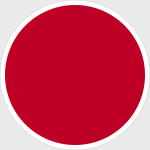Hobby Master HA8811 Imperial Japanese Navy Mitsubishi A6M2 "Zero" Type 21 Fighter - PO First Class Tsugio Matsuyama, IJN Aircraft Carrier Hiryu, Pearl Harbor, Hawaii, December 1941 (1:48 Scale)
"We have resolved to endure the unendurable and suffer what is insufferable."
- Japanese Emperor Hirohito speaking to the Japanese people after the atomic bombings, August 1945
 The Mitsubishi A6M "Zero" is a long-range carrier-based fighter aircraft formerly manufactured by Mitsubishi Aircraft Company, a part of Mitsubishi Heavy Industries. It was operated by the Imperial Japanese Navy (IJN) from 1940 to 1945. The A6M was designated as the Mitsubishi Navy Type 0 carrier fighter, or the Mitsubishi A6M Rei-sen. The A6M was usually referred to by its pilots as the Reisen (zero fighter), "0" being the last digit of the imperial year 2600 (1940) when it entered service with the Imperial Navy. The official Allied reporting name was "Zeke", although the name "Zero" was used colloquially as well.
The Mitsubishi A6M "Zero" is a long-range carrier-based fighter aircraft formerly manufactured by Mitsubishi Aircraft Company, a part of Mitsubishi Heavy Industries. It was operated by the Imperial Japanese Navy (IJN) from 1940 to 1945. The A6M was designated as the Mitsubishi Navy Type 0 carrier fighter, or the Mitsubishi A6M Rei-sen. The A6M was usually referred to by its pilots as the Reisen (zero fighter), "0" being the last digit of the imperial year 2600 (1940) when it entered service with the Imperial Navy. The official Allied reporting name was "Zeke", although the name "Zero" was used colloquially as well.
The Zero is considered to have been the most capable carrier-based fighter in the world when it was introduced early in World War II, combining excellent maneuverability and very long range. The Imperial Japanese Navy Air Service also frequently used it as a land-based fighter.
In early combat operations, the Zero gained a reputation as a dogfighter, achieving an outstanding kill ratio of 12 to 1, but by mid-1942 a combination of new tactics and the introduction of better equipment enabled Allied pilots to engage the Zero on generally equal terms. By 1943, the Zero was less effective against newer Allied fighters. The Zero lacked hydraulic boosting for its ailerons and rudder, rendering it difficult to maneuver at high speeds. Lack of self-sealing fuel tanks also made it more vulnerable than its contemporaries. By 1944, with Allied fighters approaching the A6M's levels of maneuverability and consistently exceeding its firepower, armor, and speed, the A6M had largely become outdated as a fighter aircraft. However, as design delays and production difficulties hampered the introduction of newer Japanese aircraft models, the Zero continued to serve in a front-line role until the end of the war in the Pacific. During the final phases, it was also adapted for use in kamikaze operations. Japan produced more Zeros than any other model of combat aircraft during the war.
Pictured here is a 1:48 scale replica of an Imperial Japanese Navy Mitsubishi A6M2 "Zero" Type 21 fighter that was piloted by PO First Class Tsugio Matsuyama, who was embarked upon the IJN Aircraft Carrier Hiryu, then attacking Pearl Harbor, Hawaii, during December 1941.
Now in stock!
Dimensions:
Wingspan: 9-inches
Length: 7-1/4-inches
Release Date: October 2023
Historical Account: "Swan Song" - In May 1942, the Japanese aircraft carrier Hiryu sailed on her final mission. Her aircraft complement consisted of 21 Mitsubishi A6M "Zero" fighters, 21 Aichi D3A "Val" dive bombers, and 21 Nakajima B5N "Kate" torpedo bombers. On June 4th, 1942, she took part in the battle of Midway. At 4:30 AM she launched a strike against Midway Island, destroying planes and damaging installations. After Kaga, Soryu and Akagi were disabled by air attack at about 10:25 AM, Hiryu was the only operational carrier left to the Japanese. She launched two waves of planes at 10:50 and 12:45 against Yorktown, heavily damaging the American carrier with bombs and torpedoes (she was sunk later by I-168).
Japanese search planes had located the remaining American aircraft carriers, and all surviving aircraft from the Carrier Striking Force had landed on Hiryű and were refueled and armed; but while preparing to launch a third strike against them, Hiryu was attacked at 5:03 PM by 13 SBD Dauntless dive bombers from Enterprise. She was hit by four 1000 lb (453.6 kg) bombs, three on the forward flight deck and one on or near the forward elevator. The explosions started fires among the aircraft on the hangar deck.
Although Hiryu's propulsion wasn't affected, the fires could not be brought under control. At 9:23 PM her engines stopped, and at 1:58 AM a major explosion rocked the ship. The order to abandon ship was given shortly afterwards and the survivors were taken off by the destroyers Kazagumo and Makigumo. Rear Admiral Tamon Yamaguchi and Captain Kaku remained on board as Hiryu was scuttled at 5:10 AM by torpedoes from Makigumo. She sank at 9:12 AM, taking 35 men down with her (another 350 or so had been killed by the bombs, fires and explosions). Thirty-five were rescued by the US Navy and taken prisoner. Admiral Yamaguchi's insistence on going down with his carrier robbed the Japanese of one of their most experienced and brilliant carrier admirals, while Admiral Fletcher, who abandoned the doomed Yorktown in the same battle, later became one of the primary architects of Allied victory in the Pacific.


